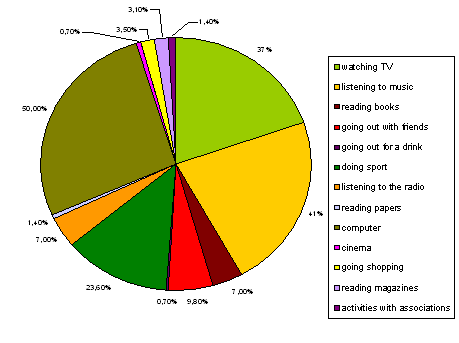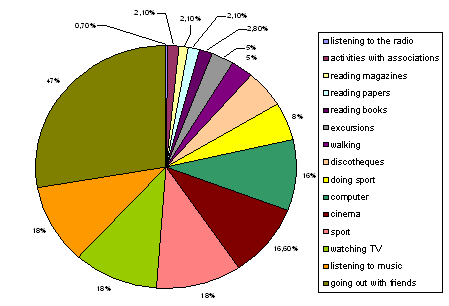
Young
people's language in Barcelona and its representation in the mass
media, by Katharina Wieland |
||||
| CONTINUA |
Graph 1: free-time
activities of adolescents (2003) on workdays Graph 2: free-time activities of adolescents
(2003) at the weekends
Graphs 1 and 2 show how adolescents aged between 12 and 18 prefer to spend their free time (they named the two most important occupations and the ones they practised most frequently). If we compare the workdays with the weekend, we can identify logical differences. At the weekend, young people have more free time and therefore more time and opportunities to meet their friends, to go shopping, to the discotheque or to the cinema than on workdays.(2) If we compare both graphs, we can see that the free-time activities that adolescents prefer are using the computer (workdays 50%, weekends 16%), watching the television (workdays 37%, weekends 18%), listening to music (workdays 41%, weekends 18.1%), doing sport (workdays 23.6%, weekends 18%) and going out with their friends (workdays 9.8%, weekends 47.2%). On the whole, we can establish two axes of adolescents' free-time behaviour: on the one hand, relationships with each other and, on the other hand, the consumption of music and information at home. These two main lines -the intergrupal behaviour of adolescents and their attitude towards the mass media- are essential factors in young people's way of living and characterise the use they make of language. This is why they make up the bulk of this study. When adolescents speak to each other they use young people's language, in other words what in the linguistic research into the German language (cf. Neuland 2003?, Augenstein 1998) is called the way in which young people speak. With this concept, the aim is to indicate that young people's language is not so much a new variety, but rather aspects of the specific language that vary from one group of young people to another. Nevertheless, it is surprising that many features are often used in the same way in all the groups, especially because of the wide dissemination made of them on the radio and on television (cf. Baumann 2001:35). Therefore, and without wishing to generalise, what Augenstein states could be absolutely valid: "[…] [some] subcultural stylistic features are commercialised and disseminated through the mass media in such a way that we can perfectly well speak about a common young people's language (1998:34). Augenstein's statement refers to the new central role of the mass media in creating and disseminating young people's language. 4. The mass media and young people's language Television can be considered to be the multiplier and also the creator par excellence of young people's language. If nothing else, in many television programmes, not just the ones aimed at young people, special attention is paid to ways of expressing that are typical of young people's culture and with their ostentatious expressive codes (Barruti 1990, Rodriguez Gonzalez 2002b). However, in reality, what amount of young people's language is contained in Catalan television programmes aimed at adolescents and young adults such as Una altra cosa or Plats bruts? This question leads us to another aspect, often the object of controversy and sometimes polemical, on the relationship between the Catalan language used in the mass media and that of the linguistic standardisation. For receivers, the language of the mass media is always spoken language, whether it appears in a relatively spontaneous way (television chats, programmes with the intervention of the public) or in a non-spontaneous way (series, films, cartoons, the news, etc.). Whether the public has the feeling that the language is a full reality depends, among other factors, on the standardised measure used to gauge linguistic reality. All too often, receivers of mass media communication have a negative reaction and one of rejection towards the linguistic standard used because it seems ridiculous, inadequate and artificial to them (cf. Sinner/Wieland and Reinke and Reinke/Ostiguy). In these cases, a conflict is often detected between the standard (written) and the oral performance, as can be seen in the following fragment taken from a conversation held with those responsible for the Linguistic Service of Televisió Catalunya:(3) AA: we try to use living/ Nevertheless, in recent years a slightly different trend has been noted in television productions for adolescents and young people. Series such as Plats bruts -and earlier the series Poble Nou (cf. Paloma i Sanllehí 1999:84), although to a notably lesser degree- use a Catalan that was less backed by the standards and more by colloquial language when representing some of the characters, which managed to obtain higher audiences and good commercial results. However, so far there is no general study on the credibility and linguistic authenticity of series or moderators. The lack of a linguistic "base" for the use of more authentic oral registers in the form of descriptive oral standards for Catalan continues to be problematic. 40 conversations held by adolescents in small groups were recorded and analysed according to the principle of participative observation. The groups were, on average, made up of three young people who had met on a voluntary basis, who have known each other for some time and who, on the whole, spend part of their free time together. For these young people, the conversation constituted a communicative situation without commitment, in which they could act freely, without having to think about whether they were being subjected to assessment.
|
||

